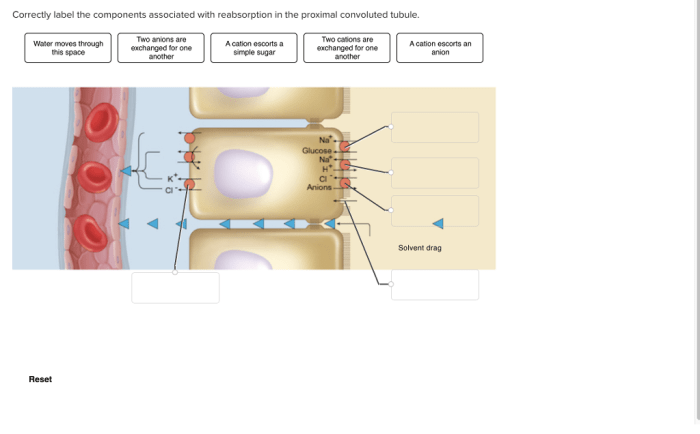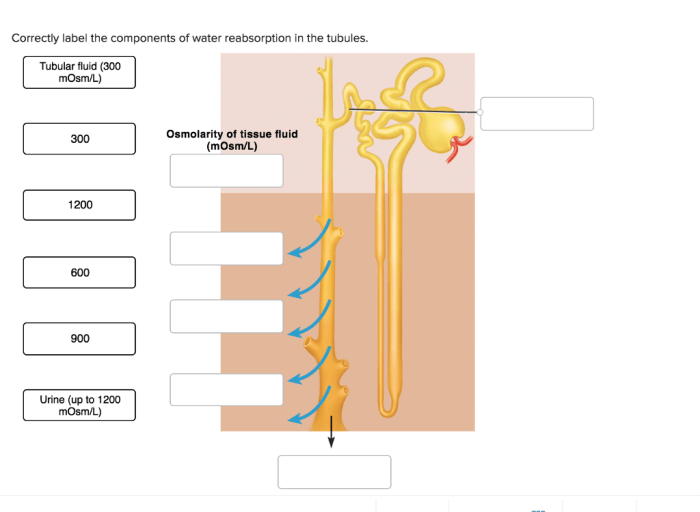Correctly label the components of water reabsorption in the tubules. – Correctly labeling the components of water reabsorption in the tubules is crucial for understanding the intricate mechanisms involved in maintaining fluid balance in the body. This process, occurring within the renal tubules, plays a vital role in regulating water homeostasis, electrolyte balance, and overall bodily function.
Water reabsorption in the tubules is a complex process involving various components, each with a distinct role. By identifying and understanding these components, we gain insights into the physiological processes that ensure proper hydration and electrolyte balance.
Water Reabsorption in the Tubules

Water reabsorption in the tubules is a critical process for maintaining fluid balance in the body. It involves the movement of water from the tubular lumen back into the bloodstream, and is essential for the regulation of blood volume, blood pressure, and electrolyte balance.
The process of water reabsorption occurs in the proximal tubule, loop of Henle, and collecting duct. In the proximal tubule, water is reabsorbed passively along with sodium ions, which are actively transported out of the lumen. In the loop of Henle, water is reabsorbed in the descending limb and excreted in the ascending limb, creating a concentration gradient that drives water reabsorption in the collecting duct.
The collecting duct is the primary site of water reabsorption. Here, water is reabsorbed in response to the antidiuretic hormone (ADH), which increases the permeability of the collecting duct to water. ADH is released by the pituitary gland in response to changes in blood osmolality, and its action is essential for maintaining water balance in the body.
Components of Water Reabsorption in the Tubules: Correctly Label The Components Of Water Reabsorption In The Tubules.

- Sodium-potassium pump:This pump is located in the basolateral membrane of the proximal tubule and loop of Henle. It actively transports sodium ions out of the tubular lumen, creating a concentration gradient that drives water reabsorption.
- Aquaporins:Aquaporins are water channels that are located in the apical membrane of the proximal tubule, loop of Henle, and collecting duct. They allow water to pass through the membrane, facilitating water reabsorption.
- Antidiuretic hormone (ADH):ADH is a hormone that is released by the pituitary gland in response to changes in blood osmolality. It increases the permeability of the collecting duct to water, promoting water reabsorption.
These components work together to facilitate water reabsorption in the tubules. The sodium-potassium pump creates a concentration gradient that drives water reabsorption, while aquaporins allow water to pass through the membrane. ADH increases the permeability of the collecting duct to water, promoting water reabsorption in response to changes in blood osmolality.
Mechanisms of Water Reabsorption in the Tubules

Water reabsorption in the tubules occurs through two main mechanisms: passive reabsorption and active reabsorption.
Passive reabsorptionoccurs in the proximal tubule and loop of Henle. In these segments, water is reabsorbed along with sodium ions, which are actively transported out of the tubular lumen by the sodium-potassium pump. The concentration gradient created by the active transport of sodium ions drives water reabsorption.
Active reabsorptionoccurs in the collecting duct. In this segment, water is reabsorbed in response to the antidiuretic hormone (ADH). ADH increases the permeability of the collecting duct to water, allowing water to pass through the membrane and into the bloodstream.
The mechanisms of water reabsorption in the tubules are regulated by a variety of factors, including blood osmolality, blood volume, and blood pressure. These factors act on the kidneys to adjust the rate of water reabsorption and maintain fluid balance in the body.
Clinical Significance of Water Reabsorption in the Tubules

Water reabsorption in the tubules is essential for maintaining fluid balance in the body. Impaired water reabsorption can lead to a variety of clinical conditions, including:
- Dehydration:Dehydration occurs when there is a loss of water from the body, leading to a decrease in blood volume and blood pressure.
- Hyponatremia:Hyponatremia occurs when the sodium concentration in the blood is too low, leading to a variety of symptoms, including nausea, vomiting, and seizures.
- Hypernatremia:Hypernatremia occurs when the sodium concentration in the blood is too high, leading to a variety of symptoms, including thirst, confusion, and seizures.
A variety of clinical conditions can affect water reabsorption in the tubules, including:
- Diabetes insipidus:Diabetes insipidus is a condition in which the kidneys are unable to concentrate urine, leading to excessive water loss and dehydration.
- Nephrogenic diabetes insipidus:Nephrogenic diabetes insipidus is a condition in which the kidneys are unable to respond to ADH, leading to excessive water loss and dehydration.
- Kidney failure:Kidney failure can lead to impaired water reabsorption, leading to fluid overload and edema.
Understanding the mechanisms of water reabsorption in the tubules is essential for the diagnosis and treatment of a variety of clinical conditions.
FAQ Resource
What is the significance of water reabsorption in the tubules?
Water reabsorption in the tubules is essential for maintaining fluid balance, regulating electrolyte concentrations, and supporting overall bodily functions.
How do the components of water reabsorption work together?
The components of water reabsorption, including aquaporins, ion transporters, and hormones, work in concert to facilitate the movement of water across the tubular epithelium.
What are the consequences of impaired water reabsorption in the tubules?
Impaired water reabsorption can lead to dehydration, electrolyte imbalances, and various clinical conditions, such as diabetes insipidus and renal failure.